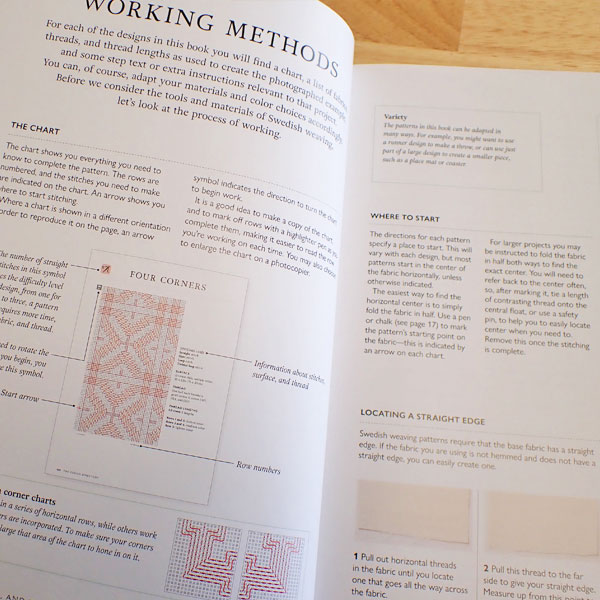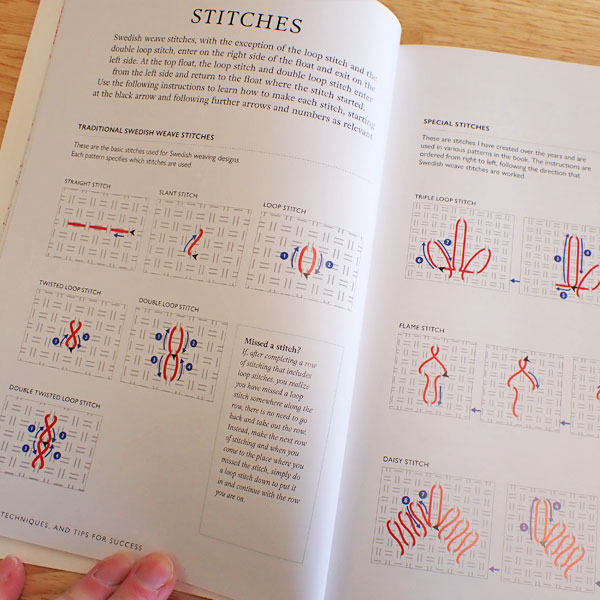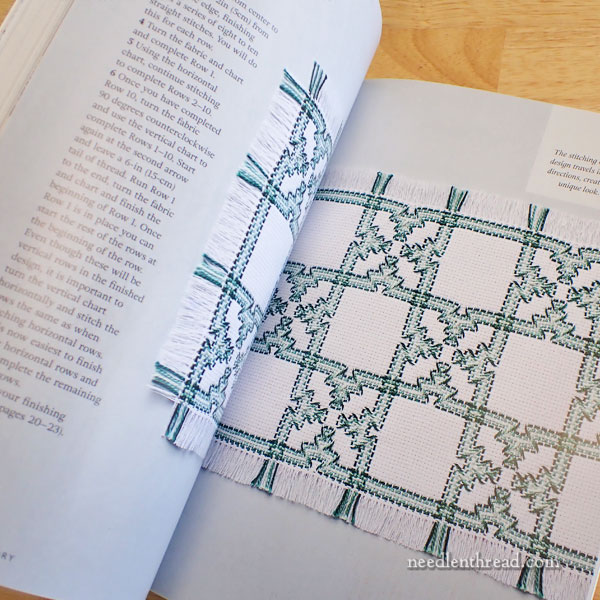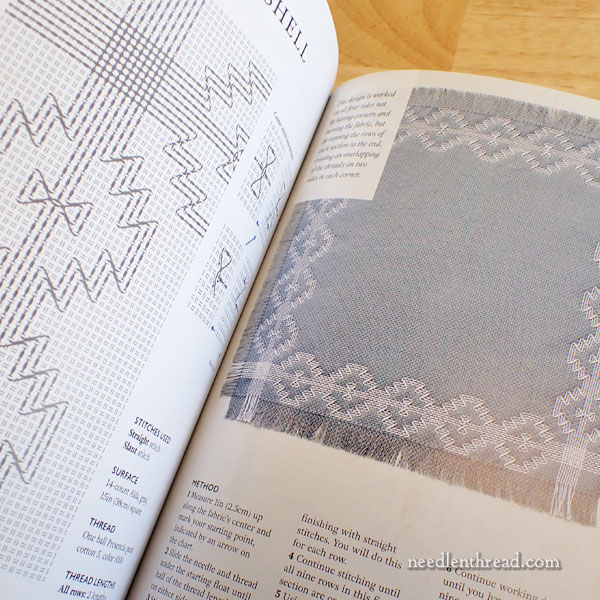Swedish weaving – or “huck embroidery” or “Swedish darning” – is enjoying a comeback lately, so we’re going to talk about it today!
While the origins of Swedish weaving are largely uncertain, extant examples date as far back as the 1600’s. It’s not even certain that the origins are necessarily Swedish, as similar styles of embellishment belong to many cultures worldwide.
What we do know for sure is that the migrant population that moved to the US at the end of the 1800’s and into the early 1900’s brought this style of embellishment with them and it because especially popular in the 1930’s and 1940’s. It was an inexpensive, yet pleasing (and highly accessible) way to embellish household goods.
The huck embroidery trend rejuvenated in the 1960’s and 1970’s along with other forms of folk embroidery, and today, it is enjoying another resurgence in popularity.
I’ve always been intrigued by this form of embellishment. Some contend that it is not proper “embroidery” because it doesn’t involve passing completely through the fabric with the needle and thread. But if you take the broad definition of embroidery – to adorn (a ground of some sort) with needle and thread – then I think it works as an embroidery topic, despite the opinion that it belongs more to the weaving niche.
Let’s chat about the technique and take a look at a new book on Swedish weaving called Swedish Weaving Pattern Directory by Katherine Kennedy.
You can find Swedish Weaving Pattern Directory available here in the Needle ‘n Thread Shop for those who want to try this unique form of embroidery, or who want to expand their explorations with a wide collection of Swedish weaving patterns written for all levels of stitchers.

Swedish weaving is somewhat folkish in style. It features undulating or linear designs as well as geometric border and filling patterns, and is often worked on towels, tea cloths, and other household linens.
In the early 1900’s, Swedish weaving was worked primarily on “huck” or “huckaback” fabric or toweling – an absorbent cotton or linen fabric with vertical floats in the weave.
These floating vertical threads provide the structure into which embroidery threads are woven to create a design. The floats allow the embroidery thread to pass between the float (which is on top of the fabric) and the fabric, so that the embroidery thread is not visible on the back.
These days, Swedish weaving makes use of other types of cloth as well – aida cloth, monks cloth, a cotton fabric called “popkorn” or “popcorn,” and even waffle-weave toweling. All of these fabrics are addressed in Swedish Weaving, with examples (and instructions) for working with each of them.

The author presents three levels of designs in the book, so that the absolute beginner can pick up the book and get right to fun of learning and stitching, and the advanced stitcher can find designs that are challenging and satisfying to stitch.

You’ll find plenty of guidance for getting started with Swedish weaving, clearly explained and illustrated with diagrams.
Especially helpful is information on reading the charted diagrams, tips on finding your starting point, squaring your edges, determining thread lengths, and more.

Additionally, you’ll find helpful guidance concerning fabrics – because huck embroidery is not just confined to huck fabric!

And you’ll find good information on thread choices.

Then, we get into instruction on stitches.
Swedish weaving is not complicated, and there are not a lot of stitches or weaving techniques. In fact, there are about three basic stitches, and three specialty stitches!
Depending on the fabric you decide to use, the stitches can come out looking decidedly difference from fabric to fabric.

The author takes the reader through working a project, so that we can see how to start, how to work through the various facets of the project, and how to end or complete it, including finishing the edges if necessary.

Then, we move into the patterns!
There are 50 patterns. Each includes the chart, a finished photo of embroidery worked with the pattern, and the information for the sample stitched: what ground fabric, what threads and how much of them, what stitches, and the working method for the project.
That’s fifty projects in this one book! Pretty impressive!

I tend to equate Swedish weaving with border designs, so I was pleasantly surprised to see a good variety of filling designs in the book, too.

The designs can be subtle or bold, all depending on your thread choice.

The samples worked with lighter threads on colored or natural fabrics are quite striking!

There’s a great variety of patterns in the book! I like the fact that there are so many to choose from. If you are a keen fan of huck embroidery, the patterns in this one book will keep you happily occupied for quite a while! And if you’re just starting to explore the technique, you’ll find a good range of projects to choose from.
I’m so happy to see this book available, helping to keep alive this stitching style. And, clocking in at less than $20, it’s a bargain, too, for fifty projects!
If you’re interested in picking up a copy of Swedish Weaving, you’ll find it available here in my shop. We’re shipping every day this week, so you can have it in your hands in no time.
Hope your week is plugging along grandly! I have to say, it’s great to be back at work all day again, in the full swing of things, with the sun shining outside the studio windows and spring bursting forth everywhere, and all kinds of diligent work going on in here. Life is good!








This is probably a really dumb question, but how does the Swedish weaving compare to darning? The techniques seems similar except that darning patterns are dense to cover an area where these weaving patterns seems more open. It’s somewhat like how blackwork appears lacy compared to other counted thread stitches.
Thanks for all the wonderful education and inspiration!
Swedish weaving doesn’t create a pattern on the back of the fabric like darning does. Darning is technically running stitch and it passes all the way through the fabric. As such, it isn’t limited to the weave of the fabric at all. Swedish weaving passes behind “floats” or “floating threads” on the front of the weave, so that the thread doesn’t actually pass all the way to the back of the fabric. This means that Swedish weaving is limited to the weave of the fabric for its foundation.
I have some samples done by my Swedish great grandmother and have always wanted to give this a try. I treasure those pieces of handwork as a direct link to the past and the woman who brought her family to this country in 1907.
Oh, you’re so lucky!! What a treasure!
Just placed my order! Back too many years ago I used to do this on the huck toweling. I think pulling this out again will be a great project for my grandkids who wants to learn to sew, and I’m excited to see all the new patterns in this book.Thank you Mary!
Thanks, Kathy! I hope you and your grandkids have fun with it!
Hi Mary,
Thank you for another lovely review.
I always wait for your reviews. I discovered your blog way back in 2009 when I finally started going to a certificate class in hand embroidery. Your videos helped me through whenever I had confusion in the class. Then I loved your free patterns and stitch-a-longs. Your book list helped me get to know the right books in this huge field. Made me wish I was in USA to order the wonderful things in your shop and to visit you. I am praying this will come true soon.
Coming back to today’s post on Huck embroidery book, it made me realise, I may need to spend a tad more effort in understanding this work to do it. always wanted to, but, huck fabric and aida fabric are unavailable in my country. I first saw this in Reader’s Digest book of Needlework and seeing about huck fabric tried to source it. When I could not, gave it up. This detailed review ofcourse makes me wish to buy the book , at the same time seeing toweling fabric mentioned makes me feel I can try it as this is available in my country.
Thank you for another lovely review.
What a rabbit hole this was! at primary school we did Swedish embroidery but have no pieces left now: then we graduated to cross stitch on gingham. All this was after working on sacking – even sewed it to my skirt once, the pain of unsewing!
Even did a set of 7 tea towels on linen which went from 2 young ones meeting to marriage and a family, they are with my niece – I think!
But do love your floral work, it is so nice to see embroidery still happening.
Cheers, Dot.
Will you hVe the Swedish Weaving pattern book available again? I am going to be teaching some ladies how to do Swedish Weaving. I have been doing it off and on for a few years. I am always interested in books and different patterns.
Thank you
This edition published in 2024 by Search Press Ltd
Wellwood North Farm Road
Tunbridge Wells
Kent TN2 3DR
Copyright © 2024 Quarto Publishing plc
All rights reserved. No part of this book may be reproduced in any form or by any means, electronic or mechanical, including photocopying, recording, or by any information storage and retrieval system, without permission in writing from the publisher.
Thanks for the information, Dawn. Here in the States, it was distributed by Penguin Random House.
Is there a question behind supplying the information? I’m not sure what the purpose of your comment is? Thanks again!